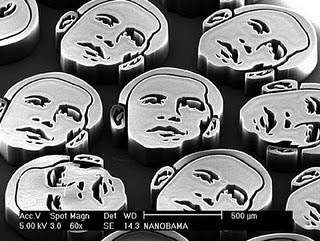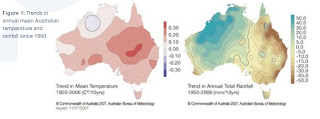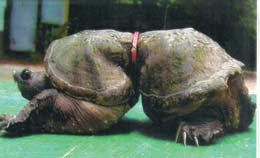.When it comes to nanotechnology, there are both possible benefits and risks involved. Those that are pro-science tend to push the benefits (and the nanoproducts) and those that are against science tend to push the risks of nanotechnology and nanopollution. Will nanotechnology help to solve environmental issues or will dangerous nanopollution and nanoweapons be the result? Will nanoscience help to reduce human suffering for many (or few) people? Or will it increase suffering? Will it boost human lifespans and lifestyles or reduce them? And who will benefit or suffer as a result of the new science and technology and its products and effects? Well, that depends on what 'society' does with the new science and technology it now increasingly has at its disposal.
."There are many people, including myself, who are quite uneasy about the consequences of this technology of the future"
Eric Drexler.
 Above:
Above: Microscopic faces of Barack Obama made using nanotechnology, and imaged using a scanning electron microscope. Each face consists of millions of vertically-aligned carbon nanotubes, grown by a high temperature chemical reaction.
Image source here.Lets have a look at the benefits first.
.Benefits of nanotechnology.Nanotechnology is already being used in many applications. For example, in modern medicine, nanotechnology is being used for fluorescent biological labels, drug and gene delivery, tissue engineering and MRI contrast enhancement. The benefits of these improved medical diagnostic methods and treatment options could be huge for those that are sick with a range of illnesses and diseases such as cancer. Those that support nanotechnology suggest the amazing possibilities of nanotechnology are almost endless.
.Strong proponents believe that, with further research and development (and funding), nanotechnology could be used to help solve a wide range of environmental and social problems including: climate change; water/air pollution; and even world hunger. However, the hype and marketing surrounding nanotechnology makes it difficult to separate what is technically possible and what may one day be available.
.It is also important to consider who will benefit. Can people access or even afford it when they may need it? Who owns, and therefore profits and controls nanotechnology? Much of the debate coming from the global 'South' in climate change, centres around the need for technology transfer, but will nanotechnology solutions be shared?
.


 Risks of nanotechnology.
Risks of nanotechnology.Consider the case of the nanosock which has nanosilver particles in them to prevent bacteria and foot odor. Preliminary results from research being conducted by Troy Benn (an Arizona State University doctoral student) were presented at the American Chemical Societies 2008 conference. The research found that nanosilver particles would come out of the sock in the wash and therefore be released into the environment. This raises serious issues, such as what happens when bacteria killing particles are released into the environment? Science cannot yet answer that question adequately so we should remember the precautionary principle (PP) and be very careful until we can. Arguments over whether a strong or weak precautionary principle should be used then begin. Those that push for less regulation argue that a strong PP would limit the pace of discovery and therefore hold back the benefits of nanotechnology to those that may really need then now (i.e. the sick or the elderly). While those that want stronger regulation believe that the unknown risks out weigh the possible benefits and slowing the pace makes it safer.
.New nanoproducts should be tested for safety before going onto the market, but currently the risk research lags behind the new products. Some of this is because we are only beginning to 'see' some of the possible risks of nanotechnology.
.Molecular nanotechnology may allow the creation of self-replicating machines and the problem of ‘grey goo’. [See: the sci-fi book '
Prey' by Michael Crichton] Is this idea of nanotechnology 'getting out of control' only 'science fiction'? Or is it a very real nasty future that awaits?
.Nanoweapons could be created, given almost half of all scientific research is for military purposes, there is a good chance that researchers will look towards nanoweapons that could deliver bioweapons – like a nanobot mosquito with a nasty toxin such as botulism). The development of nanoweapons could lead to a nanotechnology arms race, between nanotechnology superpowers or even smaller rogue states or terrorist group. There could be a large number of states with nanoweapons and because of there size they would be difficult to find and easy to smuggle which means they could be easily transported. There is also the possibility that a black-market for banned nanomachines could occur and because of the size of future nanomachines, it would be difficult to find them.
.Microscopic surveillance devices raise serious privacy concerns because individuals, governments or businesses could misuse them and it would be very difficult to deal with negative antisocial uses of the technology e.g. hidden cameras in private places such as bathrooms, or used for industrial or government espionage.
.Nanotechnology could have unintended consequences that could cause serious harm to society or the environment. Technocratic science has ‘blind-spots’ that result from its disciplinary and reductionist nature. These blind-spots could include unanticipated new illnesses, unintended negative environmental effects or major negative social change. These unintended consequences could also cause the public to lose of confidence in nanotechnology and this could effect funding.
.A lack of effective regulations to deal with the unintended consequences of nanotechnology could allow dangerous risks to be placed upon society. I believe a precautionary approach is therefore needed. It is also important to consider who owns and controls the technology, and who can have access to it (when and where it is needed).
.Having said all this - scientists actually working in fields of nanotechnology and nanoscience are increasingly aware of both the possible benefits and the possible problems. The example of genetically modified food has demonstrated to many scientists, some of the possible battles ahead. Good policy needs to stear through the minefield of the different assumptions and views on 'science' itself.
.Will the public trust nanoscience if it is found being used for weapons or polluting the environment? What if it is providing much joy and saving many lives? Many governments (including the US Government, the European Union and the Australian Government) have began to investigate the question of what should society do with nanotechnology.
.In conclusion, because there are many different values and worldviews in our society (e.g. anthropocentric, ecocentric and ecofeminism) and these values and worldviews are often conflicting, there is no one correct way of answering all the difficult ethical and environmental questions raised by rapidly progressing nanotechnology.
.Therefore, there needs to be a dialogue between all the key stakeholders, rather than a narrow group of experts. In order for the public to gain some control over the technology (Habermas question), they need to be involved in the problem definition, problem framing, discussing of options, etc. It must be a bottom-up rather than the typical top-down decision (leave it to the 'experts' i.e. scientists and economists).
.This could be achieved using a citizen’s jury (as they did with the UK nanojury). This is needed because nanotechnology has the potential to affect almost all aspects of modern society, so all people have a stake in their future and should help decide what risks they are prepared to take rather than having them thrust upon them without been consulted.
. , tell us what you think.
 Photo supplied by: PAJ Environmental Consulting
Photo supplied by: PAJ Environmental Consulting Photo supplied by: PAJ Environmental Consulting
Photo supplied by: PAJ Environmental Consulting









































